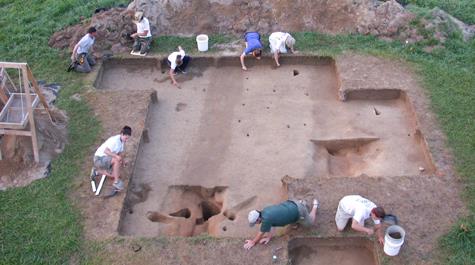Werowocomoco: A place of power, a lost city, an archaeological site, a national park
The U.S. National Park Service has taken Werowocomoco under its umbrella.
The site of Werowocomoco, Powhatan’s capital city during the early years of the Jamestown Colony, has been acquired by the National Park Service. The site will be incorporated into the Captain John Smith Chesapeake National Historic Trail, informally known as the John Smith Water Trail.
Chuck Hunt, superintendent of the John Smith Water Trail, said that planning process for the new park will unfold over the next 18 months or so. He said planning for the Werowocomoco park will involve a number of partners, including the Colonial National Historic Park, which will help with administration of the park.
Several state and local entities will participate as well, including Gloucester County, Virginia Department of Conservation and Recreation, York River State Park, Virginia Department of Historic Resources, “and I would anticipate William & Mary being an important partner,” Hunt said.
He stressed that members of the descendant Indian communities who have a shared connection to Werowocomoco will be part of the park development process as well. Seven Virginia tribes have cultural and ancestral links to Werowocomoco: the Pamunkey, the Mattaponi, the Chickahominy, the Chickahominy Eastern Division, the Rappahannock, the Upper Mattaponi and the Nansemond.
“The planning process is to determine how the park should be managed and the Virginia tribes who are associated with the site are extremely important partners,” Hunt said. “The site will be managed in a way to share their heritage and their history, because it’s a place that’s very special to them. They will be a core part of the site.”
A story in the Gloucester-Mathews Gazette-Journal broke the news that the NPS purchased the 264-acre site from The Conservation Fund, a Maryland nonprofit that bought the land from Bob and Lynn Ripley.
Ann Simonelli, media relations director at The Conservation Fund, said the focus of the nonprofit is to conserve properties of significant historic, cultural and environmental value such as the Werowocomoco.
“We work with partners like the Park Service to protect land, water and wildlife. We were established with a dual mission, to focus on conservation solutions that provide both environmental and economic benefits,” Simonelli explained, adding that development of Werowocomoco as a national park would generate an influx of tourism to Gloucester County.
Werowocomoco was the most significant city in the region at the time of the landing of the Jamestown colonists, and had probably been “a place of power” for centuries before 1607, says Martin Gallivan, professor of anthropology at William & Mary. Gallivan led an archaeological examination of the site, the precise location of which was uncertain until 2003.
The rediscovered city is prominent in early Virginia history. John Smith first entered Werowocomoco as a captive, caught in the mud at the headwaters of what is now the Chickahominy River by a squad of warriors led by sub-chief Opechancanough, brother of Powhatan. The legendary interference of Smith’s execution by Powhatan’s daughter Pocahontas occurred at Werowocomoco — if it happened at all.
The acquisition by the National Park Service is the most recent in a series of government actions to preserve Werowocomoco as a historical, cultural and archaeological site. Rumors and reports of NPS interest in Werowocomoco surfaced a couple years ago, prompting a site visit from Virginia Gov. Terry McAuliffe.
The Ripleys signed a conservation easement agreement in 2013 with the Virginia Department of Historic Resources and with representatives of the seven tribes of Virginia Indians that carry ancestral and cultural links to Werowocomoco. The National Register of Historic Places enlisted the site in 2006.
“There aren’t many places like Werowocomoco in the National Park System,” Gallivan said. “As far as I know, there aren’t any sites focused squarely on Native history in the eastern part of the country. They’re typically out west — think of Chaco Canyon, Mesa Verde, places like that.”
The National Park Service is expected to make a formal announcement of the acquisition in the fall. No specific plans have been announced on what a Werowocomoco park would include, but Gallivan has at least the outline of a wish list.
“I’d like to see a park that is clearly focused on the Native history of the Chesapeake,” Gallivan said, “a site that incorporates the voices of the contemporary Virginia Indian community which has a very special relationship to the site.”
He also said a Werowocomoco should have a strong interpretive component, accessible to the public. Archaeology has yielded a great deal of information about the site, notably the location of a 75-foot-long structure that was likely the residence of Wahunsenacawh, also known as Powhatan. But, Gallivan said, about 99 percent of the site has yet to be explored.
“So, I’d also like to see a place where archaeological research can continue to happen,” Gallivan said. “Now how you balance all of those interests in one place, well, that’s going to be quite a challenge for the National Park Service.” Skip to main content
Skip to main content

